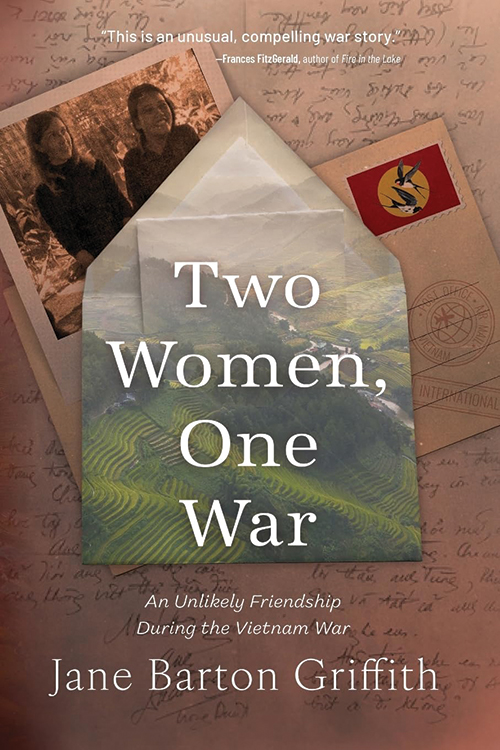
Two Women, One War: An Unlikely Friendship During the Vietnam War
Reviewed by Eileen Redden
October 1, 2025
By Jane Barton Griffith. Koehler Books, 2025. 224 pages. $26.95/hardcover; $17.95/paperback; $7.99/eBook.
This book is a memoir of a remarkable friendship between two women of different religions, nationalities, and educational backgrounds. Jane Barton Griffith and her then-husband, David, traveled to Vietnam in 1969 to serve as codirectors of an American Friends Service Committee (AFSC) humanitarian project. They worked at a rehabilitation center that provided assistance in the form of prosthetics and physical therapy. Their patients were people who had lost limbs or suffered severe burns. This facility was the only place in South Vietnam where artificial limbs and wheelchairs could be obtained at no cost and regardless of the political beliefs of the patient.
Nguyen thi Mai is a double amputee who comes to the center for medical assistance and is later offered a job as a receptionist there and invited to live in the AFSC house. A long and “unlikely friendship” develops between Griffith and Mai. As Griffith writes, “We grew to love and understand each other despite our countries wanting us to be enemies.” Mai’s thoughts and experiences are incorporated throughout the book as lengthy excerpts in her voice. I especially appreciated her contributions to the story. Mai was the one who convinced Griffith to write this book that Griffith had been talking about writing for many years.
Their friendship was able to grow because of many factors. The center was in Quang Ngai, the province suffering the greatest civilian damage of any location in Vietnam. Due to the danger and a military-enforced curfew, the residents of the AFSC house spent their evenings together. At work, Griffith spent a lot of her time in Mai’s work space. The AFSC staff was cut off from the world: making an international call required traveling to Saigon, not an easy undertaking.
Griffith contrasts the experiences of the AFSC workers with that of other Americans in Vietnam at that time. The soldiers lived on a base that mimicked the United States and had many of the comforts of home, such as American food and beer, shops, a movie theater, and a bowling alley. In contrast, the AFSC workers dressed like the Vietnamese and ate mostly rice and vegetables with an occasional bit of meat or fish. The staff learned the language, although Griffith’s language training had been abbreviated so her Vietnamese was rudimentary. Very few soldiers had any knowledge of the language, instead depending upon translators, who might abandon accuracy in some situations. AFSC required their employees to serve in Vietnam for a longer period of time than did the military. And many of the soldiers were there due to conscription, not as a voluntary act on their part.
The AFSC program was designed so that at some point it could be run by the Vietnamese. The foreigners were interacting with the Vietnamese every day in their work and even in their living space, as the AFSC house was surrounded by houses inhabited by Vietnamese residents. Journalists often visited the AFSC house and spoke to the residents, as they knew they might have information and views that were not available to them elsewhere.
Mai felt comfortable giving her coworkers feedback. AFSC was assigning only men to train to become prosthetists. The job did require physical strength, but Vietnamese women were often able to handle the physical demands. Mai pointed out that women had been attracted to communism due to the statements about gender equality. The center adopted a policy of gender equality in hiring decisions. Mai’s political connections were of great help to her coworkers several times.
Griffith left Vietnam before the fall of Saigon, and the two women did lose contact with each other for many years. Both women changed locations and jobs. Griffith got divorced; Mai was not her real name. Letters were lost, but eventually, after 35 years without contact, they were able to reconnect. Griffith had several jobs that took her back to Vietnam. Their friendship continued and even extended to their children. Mai was eventually able to travel to the United States.
I recommend this book to Friends who might want to read about women’s roles in this war. I am old enough to remember people saying at the time that our war in Vietnam was just a continuation of the war against Japanese and French control. I do not remember anyone having mentioned at that time that the war was even longer for the Vietnamese because they had fought the Chinese for many years before. Americans also tended to see the Vietnam War as a Cold War event as a war to expand communism rather than as many Vietnamese saw it: as a war of independence and patriotism. This book would be a good choice for a book club as it is not long or difficult to read. It also ends with suggested discussion questions.
Eileen Redden lives in southern Delaware and worships with the Lewes Worship Group. She serves as the young Friends book review editor for Friends Journal.
1 thought on “Two Women, One War: An Unlikely Friendship During the Vietnam War”
Leave a Reply
Comments on Friendsjournal.org may be used in the Forum of the print magazine and may be edited for length and clarity.




This is a powerful testiment to the work of AFSC! It also calls on us to look at the advances that “handicapped” people have made and the need to refunf their servives.